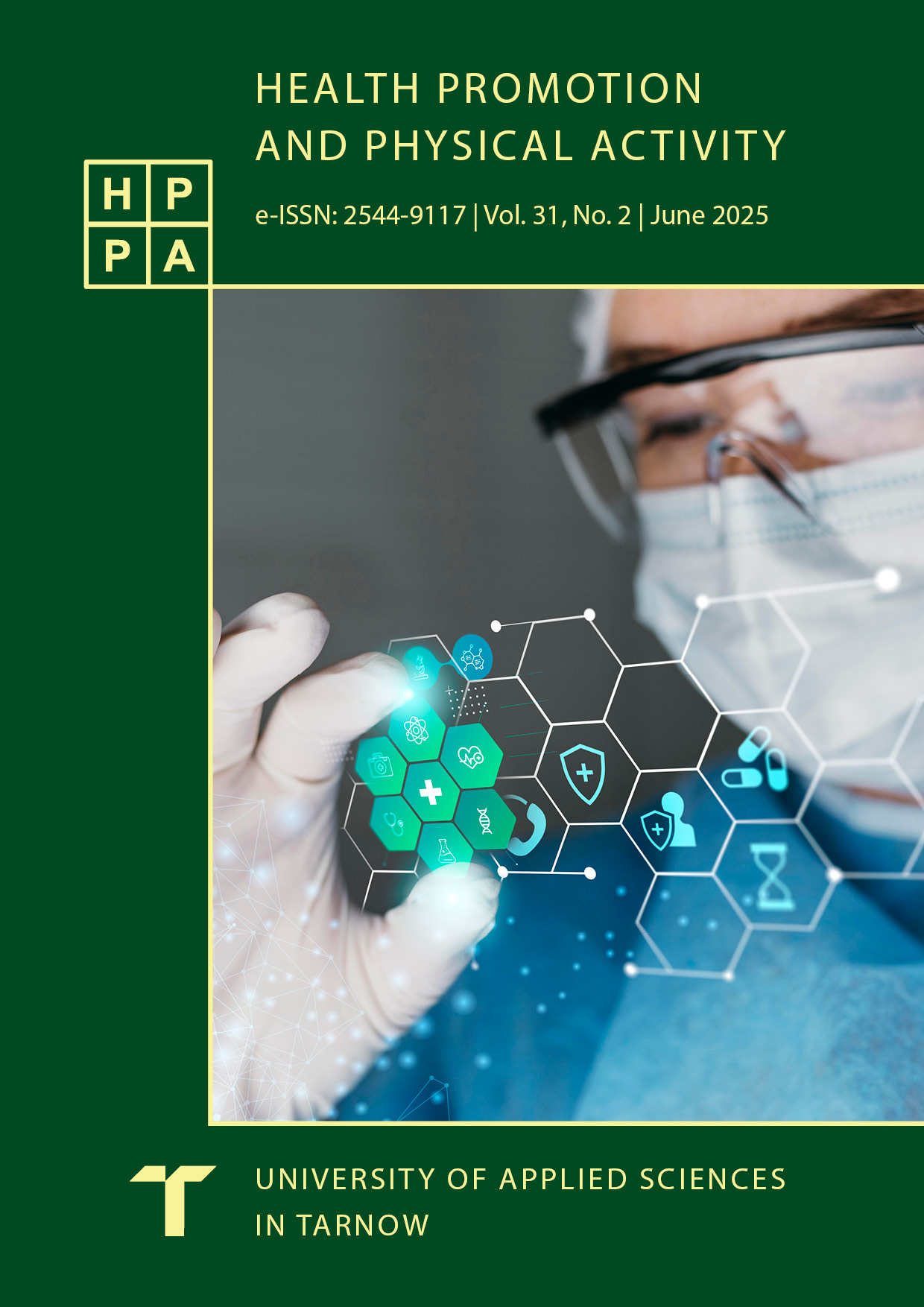11th European Hypoxia Symposium Training Centre of the German Federal Police, Kührointalm / Berchtesgaden (Germany), 26th–28th September 2025
DOI:
https://doi.org/10.55225/hppa.673Keywords:
hypoxia, medicine, conference, abstractsAbstract
The meeting continues a long tradition since some colleagues have organized the first one in 2002 in Slovenia. Hundreds of lectures followed and after a short break during the COVID-19 period the Czech team continued at Kladno and now it takes place again at the Training Centre od the German Federal Police near Berchtesgaden.
As usual colleagues were invited to contribute to all aspects of hypoxia. In addition to mountain medicine, there is diving medicine, intensive care medicine, aviation medicine, working in extreme conditions, training, and many more. There was also a special invitation to young scientists and students to present their theses. The presented abstracts are listed in alphabetical order of the first author.
Downloads
References
Angelini C. High altitude neurology. J Integrated Health. 2024;3(1):173-180. doi: 10.51219/JIH/corrado-angelini/30. DOI: https://doi.org/10.51219/JIH/corrado-angelini/30 Google Scholar
Falla M, Giardini G, Angelini C. Recommendations for traveling to altitude with neurological disorders. J Cent Nerv Syst Dis. 2021;13:11795735211053448. doi: 10.1177/11795735211053448 DOI: https://doi.org/10.1177/11795735211053448 Google Scholar
Martinuzzi A, Bartolomei L, Carrozzo R et al. Correlation between clinical and molecular features in two MELAS families. J Neurol Sci. 1992;113(2):222-229. doi: 10.1016/0022-510x(92)90250-o. DOI: https://doi.org/10.1016/0022-510X(92)90250-O Google Scholar
Angelini C, Cogo A, Madrigale G, Pecchio O, Posani L. Increased aldosterone levels in acute mountain sickness at Capanna Regina Margherita. Wilderness Environ Med. 1997;8(4):247-249. doi: 10.1580/1080-6032 DOI: https://doi.org/10.1580/1080-6032(1997)008[0247:LTTE]2.3.CO;2 Google Scholar
(1997)008[0247:ltte]2.3.co;2. Google Scholar
Angelini C, Tasca E, Nascimbeni AC, Fanin M. Muscle fatigue, nNOS and muscle fiber atrophy in limb girdle muscular dystrophy. Acta Myol. 2014;33(3):119-126. Google Scholar
McIntosh SE, Freer L, Grissom CK et al. Wilderness medical society clinical practice guidelines for the prevention and treatment of frostbite: 2024 update. Wilderness Environ Med. 2024:183-197. doi: 10.1177/10806032231222359. DOI: https://doi.org/10.1177/10806032231222359 Google Scholar
Schneider B, Gorjanc J. Frostbite incidence is a selective term and dependable on methodology — a narrative review. Health Prom Phys Act. 2023;25(4):37-43. doi: 10.55225/hppa.555. DOI: https://doi.org/10.55225/hppa.555 Google Scholar
Wibbenmeyer L, Lacey AM, Endorf FW et al. American Burn Association Clinical Practice Guidelines on the Treatment of Severe Frostbite. J Burn Care Res. 2024;45(3):541-556. doi: 10.1093/jbcr/irad022. DOI: https://doi.org/10.1093/jbcr/irad022 Google Scholar
McLeron K. State of Alaska Cold Injury Guidelines. 7th ed. Juneau, AK: Department of Health and Social Services Division of Public Health Section of Community Health and EMS; 2003. Google Scholar
Al-Rawili N, Al-Kuraishy HM, Al-Gareeb AI et al. Trajectory of cardiogenic dementia: A new perspective. J Cell Mol Med. 2025;29(2):e70345. doi: 10.1111/jcmm.70345. DOI: https://doi.org/10.1111/jcmm.70345 Google Scholar
Anazodo UC, Shoemaker JK, Suskin N, Ssali T, Wang DJ, St Lawrence KS. Impaired cerebrovascular function in coronary artery disease patients and recovery following cardiac rehabilitation. Front Aging Neurosci. 2016;7:224. doi: 10.3389/fnagi.2015.00224. DOI: https://doi.org/10.3389/fnagi.2015.00224 Google Scholar
Kasprzak D, Kaczmarek-Majer K, Rzeźniczak et al. Cognitive impairment in cardiovascular patients after myocardial infarction: Prospective clinical study. J Clin Med. 2012;12(15):4954. doi: 10.3390/jcm12154954. DOI: https://doi.org/10.3390/jcm12154954 Google Scholar
Nowak-Lis A, Gabry’s T, Nowak Z et al. The use of artificial hypoxia in endurance training in patients after myocardial infarction. Int J Environ Res. Public Health. 2021;18(4):1633-1643. doi: 10.3390/ijerph18041633. DOI: https://doi.org/10.3390/ijerph18041633 Google Scholar
Van Nieuwkerk AC, Delewi R, Wolters FJ, Muller M, Daemen M, Biessels GJ. Heart-Brain Connection Consortium: Cognitive impairment in patients with cardiac disease: Implications for clinical practice. Stroke. 2023; 54(8), 2181-2191. doi: 10.1161/STROKEAHA.123.040499. DOI: https://doi.org/10.1161/STROKEAHA.123.040499 Google Scholar
Roubík K, Sieger L, Sykora K. Work of breathing into snow in the presence versus absence of an artificial air pocket affects hypoxia and hypercapnia of a victim covered with avalanche snow: A randomized double blind crossover study. PloS One. 2015;10(12):e0144332. doi: 10.1371/journal.pone.0144332. DOI: https://doi.org/10.1371/journal.pone.0144332 Google Scholar
Roubik K, Walzel S, Horakova L, Refalo A, Sykora K, Ort V, Sieger L. Materials suitable to simulate snow during breathing experiments for avalanche survival research. Lékař a Technika – Clinician and Technology. 2020;50(1):32-39. doi: 10.14311/CTJ.2020.1.05. DOI: https://doi.org/10.14311/CTJ.2020.1.05 Google Scholar
Roubik K, Sykora K, Sieger L, Ort V, Horakova L, Walzel S. Perlite is a suitable model material for experiments investigating breathing in high density snow. Sci Rep. 2022;12(1):2070. doi: 10.1038/s41598-022-06015-y. DOI: https://doi.org/10.1038/s41598-022-06015-y Google Scholar
de Carvalho CD, Putti GM, Foresti YF et al. Recovery in normobaric hypoxia as an additional stimulus for high-intensity intermittent training. Sci Sports Med. 2023;38(2):189-196. doi: 0.1016/j.scispo.2021.12.007. DOI: https://doi.org/10.1016/j.scispo.2021.12.007 Google Scholar
Foresti YF, Carvalho CDD, Ribeiro FA et al. Acute physiological responses to “recovery intermittent hypoxia” in HIIT. Rev Bras Med Esporte. 2024;30:e2021_0499. DOI: https://doi.org/10.1590/1517-8692202430022021_0499i Google Scholar
Li SN, Anbalagan P, Pang J, Ihsan M, Girard O. Exercise responses to repeated cycle sprints with continuous and intermittent hypoxic exposure. Eur J Sport Sci. 2024;24(8): 1045-1055. doi: 10.1002/ejsc.12146. DOI: https://doi.org/10.1002/ejsc.12146 Google Scholar
Papoti M, Manchado-Gobatto FB, Gobatto CA. Inter-effort recovery hypoxia: A new paradigm in sport science? BMJ Open Sport Exerc Med. 2023;9(3):e001520. doi: 10.1136/bmjsem-2022-001520. DOI: https://doi.org/10.1136/bmjsem-2022-001520 Google Scholar
Putti G., Costa GP, Norberto MS, de Carvalho CD, Bertuzzi RCdM, Papoti M. Use of inter-effort recovery hypoxia as a new approach to improve anaerobic capacity and time to exhaustion. High Alt Med Biol. 2024;25(1):68-76. doi: 10.1089/ham.2023.0096. DOI: https://doi.org/10.1089/ham.2023.0096 Google Scholar
Elsayegh AT, Karim K, Shabana A. Impact of cardiac rehabilitation programs post primary Percutaneous Coronary Intervention on functional capacity and metabolic profile through different age groups. High Blood Press Cardiovasc Prev. 2023;30(2):145-150. doi: 10.1007/s40292-023-00566-5. DOI: https://doi.org/10.1007/s40292-023-00566-5 Google Scholar
Essop MF. Cardiac metabolic adaptations in response to chronic hypoxia. J Physiol. 2007;584(Pt 3):715–726. doi: 10.1113/jphysiol.2007.143511. DOI: https://doi.org/10.1113/jphysiol.2007.143511 Google Scholar
Higgins JP, Tuttle T, Higgins JA. Altitude and the heart: Is going high safe for your cardiac patient? Am Heart J. 2010;159(1):25-32. doi: 10.1016/j.ahj.2009.10.028. DOI: https://doi.org/10.1016/j.ahj.2009.10.028 Google Scholar
Karinen H, Peltonen J, Tikkanen H. Prevalence of acute mountain sickness among Finnish trekkers on Mount Kilimanjaro, Tanzania: An observational study. High Alt Med Biol. 2008;9(4):301-306. doi: 10.1089/ham.2008.1008. DOI: https://doi.org/10.1089/ham.2008.1008 Google Scholar
Davies AJ, Kalson NS, Stokes S et al. Determinants of summiting success and acute mountain sickness on Mt Kilimanjaro (5895 m). Wilderness Environ Med. 2009;20(4):311-317. doi: 10.1580/1080-6032-020.004.0311. DOI: https://doi.org/10.1580/1080-6032-020.004.0311 Google Scholar
Downloads
Published
How to Cite
Issue
Section
License
Copyright (c) 2025 Thomas Küpper

This work is licensed under a Creative Commons Attribution-ShareAlike 4.0 International License.









